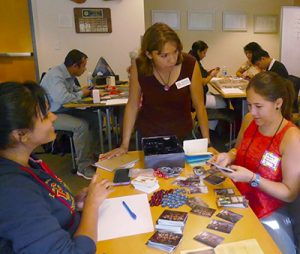Have you ever wondered if you are creative? And how many of those times have you wished to know tricks that could increase your level of creativity? Many, right?
We all know how much innovation means in today’s time. Innovation and creativity does not always mean inventing new things, but more importantly, it means doing the same thing in a different manner.
Keeping the above points in mind, the Graduate School at Syracuse University organized an International Graduate Student Workshop on Creativity and Problem-Solving, led by Dr. Martha Garcia-Murillo, a faculty member at the iSchool. The workshop was everything from fun to informative, and I was fortunate enough to be a part of it.
It attracted around 50 attendees, and included people from many different programs from all over the University. The participants were divided into groups of four, making the session all the more interactive. The workshop comprised various exercises and takeaways, and I’ll be providing a quick summary of the session for those who could not attend.
Dr. Garcia-Murillo is a political economist interested in the impact of technology in today’s society. She used creative and interactive methods to engage the audience in various exercises and the response was overwhelming. The methods she discussed to train the mind to be more creative are explained below:
1. Generate a lot of ideas
In this first exercise, we were asked to think of as many items as possible from a circular shape. You might normally think of the sun, the letter ‘O’, a pizza, etc. People who can think of more items, in this case things that have a circular shape, are considered more creative.
2. Generate original ideas
Wouldn’t it be nice to know what ‘originality’ means? It is actually not difficult when you compare your answers to those of others. So, for example, if you are presented with any random shape and then she asks you to think about as many things as possible that resemble that shape, those of you who thought of things that are different from the ones that majority of the group produced, then, you are considered to be more creative because you came up with ideas that other people did not consider.
3. Be creative using cards
For the purpose of this exercise, we were given cards with names of objects. Our groups had to pick three or four items and then combine them to develop a new product. When they combined these items, they were able to come up with unbelievably creative ideas simply by putting together things that we normally do not expect to see together.
4. Think about your audience
The same exercise with cards was repeated but the participants were now asked to think about creating a product combining these cards but now for a particular audience such as kids, or the elderly, or a minority population, for example. Once again the participants were surprised at a number of interesting products that they were able to develop for this different audiences given the combination of the random items listed on the cards.

Professor Martha Garcia-Murillo looks on as participants work on a board game where they’ve changed the rules.
5. Apply the card exercise to your academic work
When we are in school, we are asked to come up with our own ideas and sometimes we don’t know what to write. For this exercise, you can write on cards ideas of the papers you are reading, once again, combining them into bundles to see if you can come up with a new idea. In the workshop, Dr. Garcia-Murillo showed us how scholars from biology and religion were able to come up with a notion of religion spreading in a similar way to that of a virus.
6. Change the rules
In this exercise, all of the participants were given a board game. The instructions were to develop a new set of rules using the pieces of that game. This shows how it is possible for people to come up with new rules, new ideas, and new processes that can make things better. In the same way that a board game can have its rules change we can have an organization that might need to have its rules change to function better. In other words, you can also be creative in many different instances such as your work environment
7. Stop self-censoring
We all want to fit in and be liked. So we tend to self-censor by telling ourselves how wrong our idea or thought can be. What we forget is that a creative mind is always made by trial and error. There are absolutely no creative people in the world that get it right on the first try!
The key to a creative mind is persistence. You need to be determined in whatever you do. Another good practice is to always pay close attention to details which can give clues that you otherwise may not have thought of. You need to be ready to let go of your preconceived notions and adapt new ones. Be focused on your objective and know the result that you want to achieve. And never be afraid of making mistakes.
The most important thing of all I learned from this session is to have fun and enjoy the process of coming up with interesting, and perhaps crazy, ideas.
